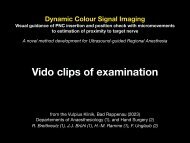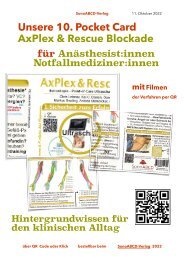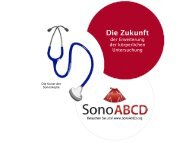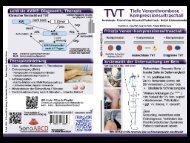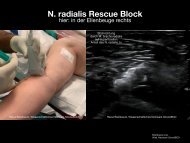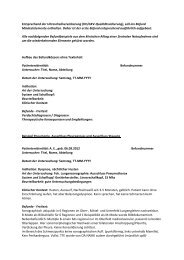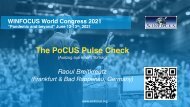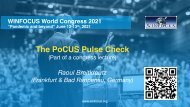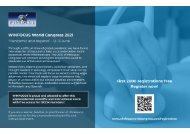Reanimationsultraschall
Dies ist das Gesamtkonzept des ALS-konformen "Resuscitation Ultrasound" = der zentralen Methoden des Reanimationsultraschalls nach den ERC Reanimations-Leitlinien von 2015 und mit POCUS 2021. Die Filme sollen den Verfahren "ein Gesicht geben". Sie können heruntergeladen werden. Weitergabe ist erlaubt :-). Eine Übersetzung auf Deutsch erfolgt nach und nach.
Dies ist das Gesamtkonzept des ALS-konformen "Resuscitation Ultrasound" = der zentralen Methoden des Reanimationsultraschalls nach den ERC Reanimations-Leitlinien von 2015 und mit POCUS 2021.
Die Filme sollen den Verfahren "ein Gesicht geben". Sie können heruntergeladen werden. Weitergabe ist erlaubt :-).
Eine Übersetzung auf Deutsch erfolgt nach und nach.
Sie wollen auch ein ePaper? Erhöhen Sie die Reichweite Ihrer Titel.
YUMPU macht aus Druck-PDFs automatisch weboptimierte ePaper, die Google liebt.
Review article<br />
nt, especially in its specificity value. Different settings, operperience,<br />
Ultrasonography and timing of the for ultrasound confirmation can cause of a endotracheal small but was tube used placement:<br />
in ten studies. 9,11,12,14–20 The sensitivity and spe<br />
mon ultrasound technique to detect esophageal intubatio<br />
nificant A influence on the diagnostic accuracy. Ultrasonogran<br />
be a useful tool for confirmation of tracheal intubation. real-time sonographic imaging during intubation has higher<br />
are both high in cadaveric models, ORs, and EDs. In ge<br />
systematic review and meta-analysis <br />
er, Eric the use H. Chou of ultrasonography a,1 , Eitan Dickmanor a , any Po-Yang method Tsouas b , Mark the sole Tessarotivity a , Yang-Ming for detection Tsai c , of esophageal Additional intubation information<br />
than post-intu<br />
Matthew Huei-Ming Ma d , Chien-Chang Lee c,d,∗ , John Marshall a<br />
a Department of Emergency Medicine, Maimonides Medical Center, Brooklyn, NY, USA<br />
b College of Medicine, National Yang-Ming University, Taipei, Taiwan<br />
c Department of Emergency Medicine, National Taiwan University Hospital Yunlin Branch, Douliou, Taiwan<br />
d Department of Emergency Medicine, National Taiwan University Hospital, Taipei, Taiwan<br />
Resuscitation 90 (2015) 97–103<br />
a r t i c l e i n f o<br />
Article history:<br />
Received 19 November 2014<br />
Received in revised form 11 February 2015<br />
Accepted 12 February 2015<br />
Keywords:<br />
Intubation<br />
Airway management<br />
Ultrasonography<br />
Resuscitation<br />
Meta-analysis<br />
Critical care<br />
a b s t r a c t<br />
Objective: This study aimed to undertake a systematic review and meta-analysis to summarize evidence<br />
on the diagnostic value of ultrasonography for the assessment of endotracheal tube placement in adult<br />
patients.<br />
Methods: The major databases, PubMed, EMBASE, and the Cochrane Library, were searched for studies<br />
published from inception to June 2014. We selected studies that used ultrasonography to confirm endotracheal<br />
tube placement. The search was limited to human studies, and had no publication date or country<br />
restrictions. Exclusion criteria included case reports, comments, reviews, guidelines and animal studies.<br />
Two reviewers extracted and verified the data independently. We summarized test performance characteristics<br />
with the use of forest plots, hierarchical summary receiver operating characteristic (HSROC)<br />
curves, and bivariate random effect models. Meta-regression analysis was performed to explore the<br />
source of heterogeneity. The methodological quality of individual studies was evaluated using the Quality<br />
Assessment of Diagnostic Accuracy Studies (QUADAS) tool.<br />
Results: A total of 12 eligible studies involving adult patients and cadaveric models were identified<br />
from 1488 references. For detection of esophageal intubation, the pooled sensitivity was 0.93 (95%CI:<br />
0.86–0.96) and the specificity was 0.97 (95%CI: 0.95–0.98). The area under the summary ROC curve was<br />
0.97 (95%CI: 0.95–0.98). The positive and negative likelihood ratios were 26.98 (95%CI: 19.32–37.66) and<br />
0.08 (95%CI: 0.04–0.15), respectively.<br />
Conclusions: Current evidence supports that ultrasonography has high diagnostic value for identifying<br />
esophageal intubation. With optimal sensitivity and specificity, ultrasonography can be a valuable adjunct<br />
in this aspect of airway assessment, especially in situations where capnography may be unreliable.<br />
© 2015 Elsevier Ireland Ltd. All rights reserved.<br />
1. Introduction<br />
Tracheal intubation serves as definite airway control when<br />
resuscitating critically ill patients. Confirmation of proper tube<br />
placement should be completed in all patients at the time of initial<br />
intubation. Unrecognized misplacement of the endotracheal tube<br />
may lead to avoidable morbidity including neurological damage,<br />
and death, with a reported incidence of 6–16%. 1,2 Thus, immediate<br />
post-intubation airway assessment is an essential clinical skill<br />
for every physician in emergency medicine (EM), anesthesia and<br />
critical care medicine. There are multiple options for confirming<br />
tracheal intubation and all methods have unique limitations. 3–5<br />
According to the 2010 American Heart Association (AHA) guideline,




